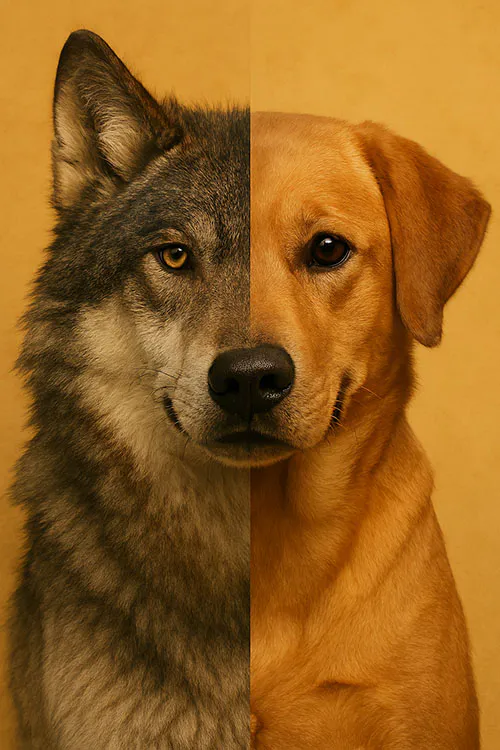
From the vast steppes of prehistoric Eurasia to the bustling cities of the modern world, dogs have been our constant companions, protectors and friends.
They have guarded our homes, herded our livestock, hunted by our side and warmed our hearts. Dogs are the species most closely associated with humans, and their story is inextricably linked with our own; a testament to one of the most successful and influential inter-species partnerships in the history of our planet.
We all know that dogs come from wolves, but which wolves? When and how? And why wolves, and not any other animal?
To shed some light on this, let’s do a whirlwind tour of wolf evolution, beginning with the emergence of the Canidae family approximately 40 million years ago. The canid family is distinguished by several common characteristics that we can recognise in modern dogs. For a start, they walk on their toes (digitigrade stance) and have non-retractable claws. They also typically have long snouts and carnassial teeth, which are adapted for shearing meat. But most of all, canids are largely social animals.
At this point in history, we’re still a few million years away from wolves, but bear with me: we’ll get there in just a few paragraphs!
The earliest known canid was Prohesperocyon wilsoni, a small, weasel-sized animal found in what is now Texas, and from there the canid family rapidly diversified into three groups:
Hesperocyoninae (~40m–15m years ago): These were the earliest and most primitive canids, generally small and fox-like in appearance. They went extinct without leaving any modern descendants.
Borophaginae (~36m–2m years ago): The name means ‘bone crushing dogs’ and these canids were big! Some were among the largest canids ever to exist: Epicyon haydeni was around 2.4m long (nearly 8 ft) and weighed up to 170kg (375 lbs). This subfamily also went extinct without modern descendants, which is probably a relief.
Caninae (~34 m years ago to present): This is the only surviving subfamily of canids and includes all modern species. Early members of this group were generally small and fox-like, but they eventually gave rise to a wide variety of forms, including the genus Canis that includes wolves.
Canis emerged relatively recently in evolutionary terms, approximately 5–6 million years ago. The earliest known member was Canis lepophagus, a North American canid that was intermediate in size between a coyote and a wolf. From this early species, several lineages evolved, including coyotes, jackals, some extinct species such as the dire wolf, and the wolf, Canis lupus.
By about 300,000 years ago, Canis lupus had evolved into a form very similar to modern grey wolves and was incredibly widespread; they once had one of the largest natural distributions of any mammal, spanning almost all the Northern Hemisphere. This wide range led to the evolution of numerous subspecies adapted to local conditions, and we see this adaptation mirrored in the wide range of dogs today.
We’ve almost finished with our brief look at wolves, but there’s one more thing to say, which might come as a surprise.
In 2016, a study by Fan et al. examined canine genomes and found that ‘all extant wolves have a surprisingly recent common ancestry’. Furthermore, ‘no single wolf population is more closely related to dogs [than any other]’.
This might not sound all that exciting, but the implication is huge: if dogs were descended from the grey wolves still found across North America and Eurasia, then dogs would be more closely related to grey wolves than to any other wolf species alive or dead. But they’re not; they’re equally related to all of them. This tells us that they all share a common ancestor of extinct wolves known as Late Pleistocene wolf. Wolves and dogs have continued to evolve, so the most we can say about modern wolves is that they’re the cousins of modern dogs, rather than their ancestors.
So, why wolves? Why not bears or foxes or any other animal? The answer becomes clear when we consider several characteristics of these early wolves that made them ideal for domestication:
Social structure: Wolves' pack structure, with its emphasis on cooperation and social bonds, provided a foundation for forming relationships with humans. It also meant that their ability to recognise and respond to social cues within their packs translated well to interpreting human social signals.
Cognitive abilities: Wolves demonstrate problem-solving skills and the ability to learn from observation; traits that would be valuable in a human-animal partnership.
Physical adaptability: As I mentioned, wolves’ ability to thrive in diverse environments probably contributed to dogs’ adaptability to various human societies and climates.
Reproductive patterns: Wolves' reproductive cycle, with females fertile only once a year, made it feasible for early humans to control their breeding.
Diet: Although wolves are primarily carnivorous, their ability to survive on a varied diet made them ideally suited to life alongside humans and their food scraps.
Age-related behaviour: Wolf cubs, like dog puppies, go through a critical socialisation period where they're open to forming bonds, which would have facilitated their integration into human groups.
We can now see that wolves were always going to be the most likely animals to fit in with humans, but you can’t just befriend a wolf without painful consequences. So when and how did wolves become dogs?
Let's look at that in Part 2: From enemies to companions.


